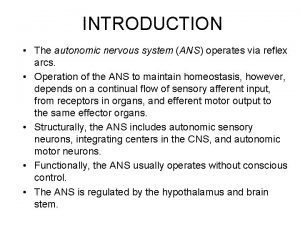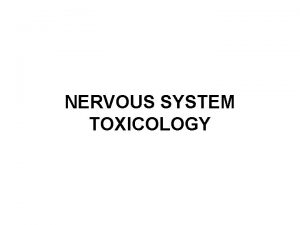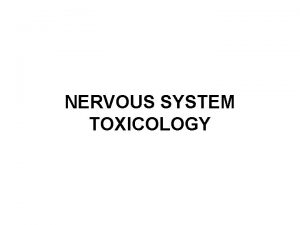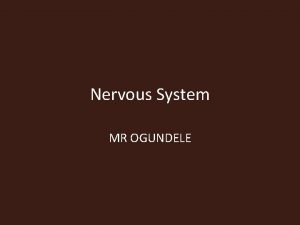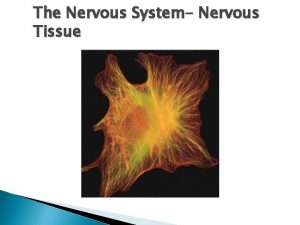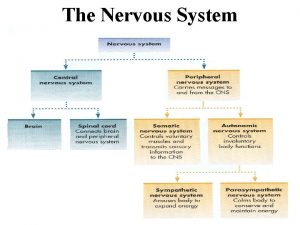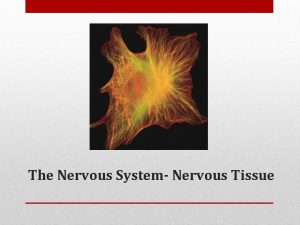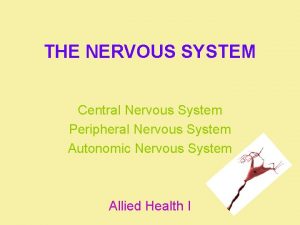Introduction Action Potential in the Nervous System Conveys


























- Slides: 26

Introduction �Action Potential in the Nervous System ◦ Conveys information over long distances ◦ Cytosol has negative charge relative to extracellular space ◦ Neural code - frequency and pattern ◦ Action potential �Spike �Nerve impulse �Discharge

Properties of the Action Potential �The Ups and Downs of an Action Potential ◦ Oscilloscope to visualize an AP �Rising phase, overshoot, falling phase, and undershoot

Properties of the Action Potential �The Generation of an Action Potential ◦ Caused by depolarization of membrane beyond threshold ◦ “All-or-none” ◦ Chain reaction �e. g. , Puncture foot, stretch membrane of nerve fibers ◦ Opens Na+-permeable channels Na+ influx depolarized membrane reaches threshold action potential

Properties of the Action Potential �The Generation of Multiple Action Potentials ◦ Artificially inject current into a neuron using a microelectrode

Properties of the Action Potential �The Generation of Multiple Action Potentials (Cont’d) ◦ Firing frequency reflects the magnitude of the depolarizing current

The Action Potential, In Theory �Depolarization (influx of Na+) and repolarization (efflux of K+) �Membrane Currents and Conductances ◦ Current �The net movement of K+ across membrane ◦ Potassium channel number �Proportional to electrical conductances ◦ Membrane potassium current �Flow and driving force

The Action Potential, In Theory �Membrane Currents and Conductances (Cont’d)

The Action Potential, In Theory �The Ins and Outs of an Action Potential �Rising phase: Inward sodium current ◦ Falling phase: Outward potassium current

The Action Potential, In Reality �The Generation of an Action Potential ◦ Hodgkin and Huxley �Voltage Clamp: “Clamp” membrane potential at any chosen value �Rising phase transient increase in g. Na, influx of Na+ ions �Falling phase increase in g. K, efflux of K+ ions �Existence of sodium “gates” in the axonal membrane

The Action Potential, In Reality �The Voltage-Gated Sodium Channel ◦ Structure –transmembrane domains and ion-selective pore

The Action Potential, In Reality �The Voltage-Gated Sodium Channel (Cont’d) ◦ Structure – gating and pore selectivity

The Action Potential, In Reality �The Voltage-Gated Sodium Channel ◦ Patch-clamp method (Erwin Neher)

The Action Potential, In Reality �The Voltage-Gated Sodium Channel (Cont’d) ◦ Functional Properties of the Sodium Channel �Open with little delay �Stay open for about 1 msec �Cannot be open again by depolarization �Absolute refractory period: Channels are inactivated

The Action Potential, In Reality � The Voltage-Gated Sodium Channel (Cont’d) ◦ In genetic disease – channelopathies �e. g. , Generalized epilepsy with febrile seizures ◦ Toxins as experimental tools �Toshio Narahashi – ion channel pharmacology �Puffer fish: Tetrodotoxin (TTX)- Clogs Na+ permeable pore �Red Tide: Saxitoxin- Na+ Channel-blocking toxin

Puffer fish Tetraodontidae Lillies Phyllobates terribilis Buttercups

The Action Potential, In Reality �The Voltage-Gated Sodium Channel (Cont’d) ◦ Varieties of toxins �Batrachotoxin (frog): Blocks inactivation so channels remain open �Veratridine (lilies): Inactivates channels �Aconitine (buttercups): Inactivates channels ◦ Differential toxin binding sites: Clues about 3 D structure of channels

The Action Potential, In Reality �Voltage-Gated Potassium Channels ◦ Potassium vs. sodium gates �Both open in response to depolarization �Potassium gates open later than sodium gates ◦ Delayed rectifier �Potassium conductance serves to rectify or reset membrane potential ◦ Structure: Four separate polypeptide subunits join to form a pore

The Action Potential, In Reality �Key Properties of the Action ◦ Threshold ◦ Rising phase ◦ Overshoot ◦ Falling phase ◦ Undershoot ◦ Absolute refractory period ◦ Relative refractory period Potential

The Action Potential, In Reality � Molecular basis of AP

�Propagation Action Potential Conduction

Action Potential Conduction �Propagation of the action potential ◦ Orthodromic: Action potential travels in one direction - down axon to the axon terminal ◦ Antidromic (experimental): Backward propagation ◦ Typical conduction velocity: 10 m/sec ◦ Length of action potential: 2 msec

Action Potential Conduction �Factors Influencing Conduction Velocity ◦ Spread of action potential along membrane �Dependent upon axon structure ◦ Path of the positive charge �Inside of the axon (faster) �Across the axonal membrane (slower) ◦ Axonal excitability �Axonal diameter (bigger = faster) �Number of voltage-gated channels

Action Potential Conduction � Factors Influencing Conduction Velocity ◦ Myelin: Layers of myelin sheath facilitate current flow �Myelinating cells ◦ Schwann cells in the PNS ◦ Oligodendroglia in CNS

Action Potential Conduction �Factors Influencing Conduction Velocity ◦ Saltatory conduction at Nodes of Ranvier ◦ Voltage gated sodium channels concentrated at nodes

Action Potentials, Axons, and Dendrites � Spike-initiation zone ◦ Sensory nerve endings ◦ Axon hillock

Concluding Remarks �Neuronal signal transmitted as the generation and regeneration of APs ◦ e. g. , : Puncture the skin nerves stretch Na+channels open AP initiated and propagated information is “communicated” to next neuron across the membrane (synaptic transmission) ◦ Emerging picture: The brain as an interconnected mesh of membranes �Next: Synaptic transmission-information transfer
 Neural circuits the organization of neuronal pools
Neural circuits the organization of neuronal pools Sensory input and motor output
Sensory input and motor output Neuronal pools are collections of
Neuronal pools are collections of Neuronal pool
Neuronal pool Graded potential and action potential
Graded potential and action potential Graded potential
Graded potential Graded vs action potential
Graded vs action potential Absolute refractory period
Absolute refractory period Source of bioelectric potential is
Source of bioelectric potential is Hypopolarization
Hypopolarization Rocuronium dose
Rocuronium dose Axon hillock
Axon hillock Action potential resting potential
Action potential resting potential Oculomotor nerve
Oculomotor nerve Dynamics in baroque music
Dynamics in baroque music Nervous system and digestive system
Nervous system and digestive system Endocrine system and nervous system
Endocrine system and nervous system Mechanism of hormone action
Mechanism of hormone action Adh function
Adh function Why is water potential measured in pascals
Why is water potential measured in pascals Waterpotential
Waterpotential Water potential
Water potential Water potential
Water potential Sales potential vs market potential
Sales potential vs market potential Define electric potential and potential difference.
Define electric potential and potential difference. Electric potential units
Electric potential units Electric potential and potential difference
Electric potential and potential difference













